This section covers resources for research on all aspects of Russian music of all types such as classical, folk, popular, religious and operatic. Please note that many Russian musical topics are included in western language sources from bibliographies and specialized encyclopedias to websites and on-line databases. Described below are major sources for music research either published in the Russian language or in other languages but specifically about Russian music. Use the Russian music guides annotated below to find other works that are not listed in this brief introduction.
Guides
Subject guides are often the best way to delve into a topic, for they discuss the various types of publications and reference works for a field of interest as well as often introducing the publishing history for that field. For music we include five items that fall under this category, two annotated bibliographies of bibliographies for Russian music and two annotated bibliographies of reference sources for Russian music and a bibliographic survey. All five are discussed immediately below. Unless you are interested only in materials published after 1995, these sources should be your first stop for musical research.
Bibliografiia muzykal’noi bibliografii. Annotirovannyi perechen’ ukazatelei literatury, izdannoi na russkom iazyke.
Moskva: Gosudarstvennaia ordena Lenina Biblioteka SSSR im. V. I. Lenina, 1963. 225 p.
U of I Library Call Number: International and Area Studies Russian Reference (Slavic) 016.78 M851b. Note: Copy 2 at Oak Street Facility. Note 2: microfilm copy at History, Philosophy & Newspaper.
This guide is primarily devoted to bibliographic works on specific musicians up to 1962. The first seventy pages cover bibliographies of a more general nature. The remaining one hundred forty pages are devoted to the bibliography of specific individuals. Each section gives a general description of research strategies in the area. The section describing the sources on archival material is very helpful for the scholar beginning his/her research in this subject area. The guide is divided into several sections: Marx, Engels, and Lenin on art; general bibliographic literature on music; bibliographic literature on specific areas of musical culture; music education; personalia of musical culture. It includes a name index.
The annotations are quite thorough providing the researcher with a clear idea of the organization, coverage and comprehensiveness of the title under discussion. The section on individual artists is arranged alphabetically by their surnames. The opening remarks in this publication can also give the scholar new to the field an idea of other helpful resources. See the entry below for the composer Vladimir Mikhailovich Deshevov which describes a bibliography of works that appears as part of a biography about him.

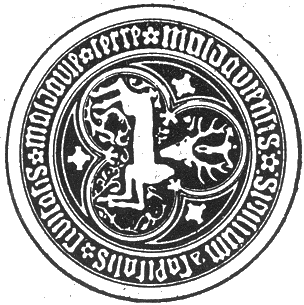
Ukazatel’ bibliograficheskikh posobii po muzyke. Annotirovannyi perechen’ ukazatelei literatury, izdannykh na russkom iazyke. 1968-1975 gg.
Moskva: Gosudarstvennaia biblioteka SSSR im. V.I. Lenina, 1978. 111 p.
U of I Library Call Number: History, Philosophy & Newspaper 016.78 P289u
This resource is intended to be a continuation to the 1963 guide discussed above. It includes works about Russian music published from 1968-1975. For the most part it follows the same organization with broad subject categories and a section for works about specific composers. There is a name index to enhance access to the text. See the entry below under the heading Turkmen Music.


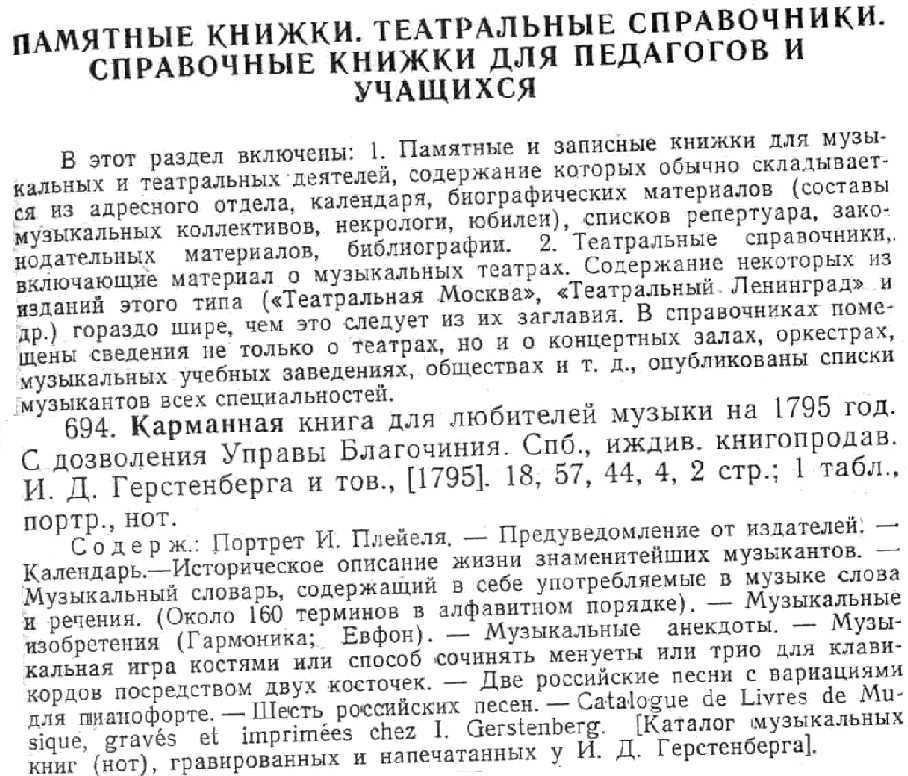
Spravochnaia literatura po muzyke. Slovari, sborniki biografii, kalendari, khroniki, pamiatnye knizhki, putevoditeli, sborniki libretto, sborniki tsitat. Ukazatel’ izdanii na russkom iazyke 1773-1962.
Moskva: Izd-vo “Kniga”, 1964. 249 p.
U of I Library Call Number: International and Area Studies Russian Reference (Slavic) 016.78 M85s
While the guide above covers bibliographies of bibliographies for Russian music, this guide covers other types of reference materials that can be used for research on Russian music and ballet. For example, there are sections on encyclopedias, dictionaries of musical terminology, catalogs of musical works, and biographical sources among others. There are also sections for the music of the various nationalities of the Soviet Union. Entries provide complete bibliographic citations and brief annotations. Some even have citations to reviews of that particular source. The text is supplemented by an extensive name index which leads you to reference sources which contain entries on that individual. There is also an index to authors and titles of the works included in the guide. See the example on the left for the section on Memorial handbooks and theater guides.

Spravochnaia literatura po muzyke. Annotirovannyi ukazatel’ izdanii na russkom iazyke 1979-1995.
Zvereva, O.M.; Pavlova, N.G. Moskva: Pashkov dom, 2000. 299 p.
U of I Library Call Number: International and Area Studies Russian Reference (Slavic) 016.78 Z89s
Published in 2000, this is the most recent guide to Russian music. It provides detailed annotations of reference books in the Russian language on various aspects of Russian and world music that were published between 1979 and 1995. If applicable, citations for published reviews are also noted at the end of the annotation. Included are discussions of encyclopedias, biographical and terminological dictionaries, calendars, anthologies and other sources. There are also some citations for bibliographies that appear as journal articles. An extremely useful index of names details the contents of all of the biographical dictionaries presented in the work. A separate index for authors, editors, and titles precedes the biographical dictionary index. See the atypically brief entry for a discography of the Beatles.


Istochnikovedenie istorii russkoi muzykal’noi kul’tury XVIII-nachala XX veka.
Petrovskaia, I. Moskva: Muzyka, 1989. 2-e, dopol. izd. 318 p.
U of I Library Call Number: Oak Street Facility 780.947 P449i 1989
This source provides an overview of the printed and manuscript sources which pertain to Russian musical life up to 1985. Topics are presented as bibliographic essays that initially discuss the genre of the source and then move on to particulars for Russian music. Representative chapters concern, for example, memoirs as an historical source, the periodical press, correspondence and diaries, biographica which includes necrologies, genealogies, biographical dictionaries and other sources of biographical information, and printed music among others. There is an index of names, but unfortunately, no compiled bibliography of sources mentioned in the text.
Musical Bibliographies
Notnaia letopis’.
Earlier title = Letopis’ muzykal’noi literatury.
Moskva: Izd-vo “Kniga”, 1931-.
U of I Library Call Number: Music & Performing Arts Periodicals 016.780947 L569, U of I’s holdings begin with 1957.
Part of the national bibliography of Russia, Notnaia letopis’ provides citations for printed music regardless of language that were published in Russia and the Former Soviet Union. This includes music that appears in journals and collections as well as music that is published individually. It does not include items about music. For that see Muzyka, Knizhnaia letopis’ and Letopis’ zhurnal’nykh statei. This title covers music from 1931 to the present day. For listings of music from 1918-1923 see Knizhnaia letopis’. From 1924-1930 music was not covered by the national bibliography. Although non-Russian titles are tracked, the citations are all given in Russian. There are annual indexes which include names, titles, and first lines. The entries are arranged in broad categories such as Musical Folklore, Vocal Music, Instrumental Music, etc. For the classification scheme used in arranging the citations look at the end of the first issue of every year. See the entries given below to get an idea of how the classification system works. To read more about Notnaia letopis’ see the Komarova article published to commemorate its 50-year anniversary.


Muzyka. Bibliograficheskaia informatsiia.
Moskva: RGB, 1973- .
U of I Library Call Number: International and Area Studies Current Periodicals (Slavic) 016.78 M9882, Recent issues + Main Stacks 1986:4-2013.
If you want to find out what is being written about music by music scholars, this is the bibliography to use. Produced by the Russian State Library in Moscow, this is a major bibliography in the field of music. It covers books, chapters, and periodical articles on all aspects of music, Russian and non-Russian. It indexes major musicological periodicals published in Russia, Eastern Europe and the West which are received by the Russian State Library. The list of the journals and issues covered appears at the back of each issue. Citations for items written in languages other than Russian have their titles translated into Russian which often resemble short abstracts. The citations are arranged by topic. Use the table of contents to follow the subject classification. There are indexes for authors, book titles, and proper names. See the entries below under the subjects Modality and Tonality from Vypusk 3, 1996.


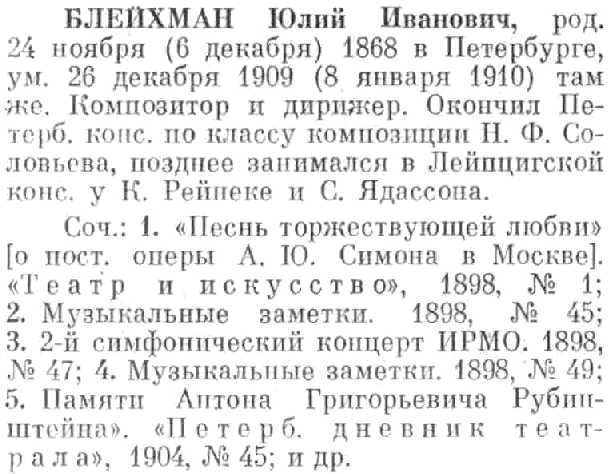
Kto pisal o muzyke: Bio-bibliograficheskii slovar’ muzykal’nykh kritikov i lits, pisavshikh o muzyke v dorevoliutsionnoi Rossii i SSSR.
Bernandt, G.B.; Iampol’skii, I.M. Moskva: Sovetskii kompozitor, 1971-1989. 4 vols.
U of I Library Call Number: International & Area Studies Russian Reference (Slavic) 016.780947 B45k v.1-3 [U of I lacks tom 4]
Although this four-volume set contains brief biographical data on Russian and Soviet musicologists, it appears here under the bibliography section because of its extensive bibliographic component which actually forms the bulk of each entry. The bibliographies contain references to books and articles written by each musicologist. Some citations with vague titles include brief explanations in brackets of the content of the item cited. The articles are arranged by surname of the individual. Unfortunately, there are no indexes to provide access to the contents of the citations. See the entry to the left for information on the works of Iulii Ivanovich Bleikhman.

Literatura o muzyke. Bibliograficheskii ukazatel’.
Moskva: Izd-vo Vsesoiuznoi knizhnoi palaty, 1955-74.
U of I Library Call Number: International & Area Studies Russian Reference (Slavic) 016.78 So89 1918-1947, 1948-1953, 1957, 1958-1959, 1960-1962, 1963-1965, 1966-1967
U of I Library Call Number: International & Area Studies Russian Reference (Slavic) 016.78 Us6l1958 1954-1956
This multi-volume bibliography of music-related publications from the Soviet Union covers the years 1918-1967. The first volume, 1918-1947, includes only books and other items like concert programs that were included in Knizhnaia letopis’, the book section of the Russian national bibliography. The later volumes of the set expand their scope to cover not only books, but also reviews and articles from journals and a few newspapers that are listed in other parts of the national bibliography such as Letopis’ zhurnalnykh statei. The citations are organized into broad categories which change slightly over the years: general topics, music history, music of the peoples of the USSR, musical theater, bibliography, music of foreign countries, etc. Use the table of contents provided in each one to determine the differences, if any, to the desired topic. Within the subject categories the citations are arranged chronologically. Every volume has a name index. See the entries below for the Sverdlovskii teatr muzykal’noi komedii from the volume for 1954-1956.
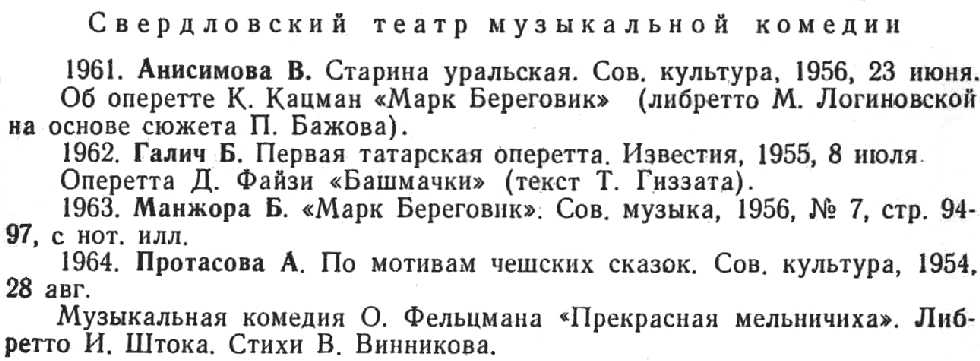

Svodnyi katalog rossiiskikh notnykh izdanii. Tom 1. XVIII vek.
Bezuglova, I.F. Sankt-Peterburg: Izd-vo RNB, 1996. 179 p.
U of I Library Call Number: International & Area Studies Russian Reference (Slavic) and Main Stacks 016.780947 Sv51 v.1
This bibliography is a Russian union catalog, or a catalog of library locations, for 18th century Russian musical publications. As a bibliography this source is important because it traces not only individual publications, but also reviews of those works published in newspapers such as Moskovskiia viedomosti and Sankt-Peterburgskiia viedomosti. There are several indexes including ones for names, titles, first lines, publishers, chronology, among others. A bibliography of sources consulted in the compiling of the resource appears at the back. See the entry below for a work by L. Madonis.
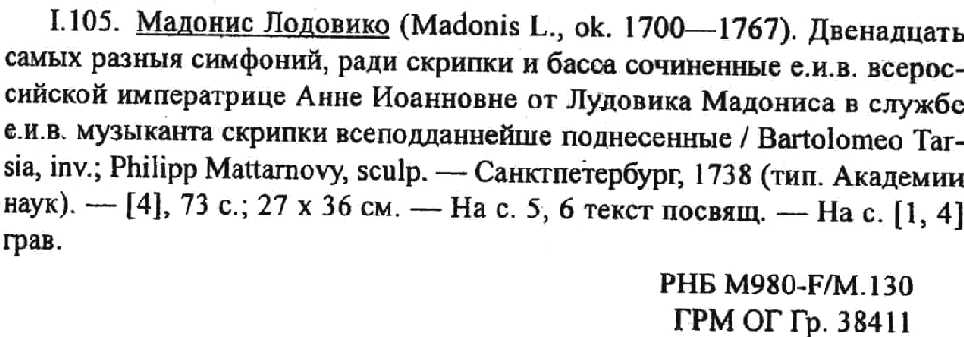

Traditsionnye zhanry pravoslavnogo pevcheskogo iskusstva v tvorchestve russkikh kompozitorov ot Glinki do Rakhmaninova 1825-1917. Istoricheskii ocherk, notografiia, bibliografiia.
Levashev, E.M. Moskva: Nezavis. Izdat. Tzentr TekhnoInfo, 1994. 105 p.
U of I Library Call Number: International & Area Studies Russian Reference (Slavic) 781.7100947 L575t
The title of this work can be misleading as to its real content, that of a bibliography for works of and about Russian religious vocal music and not just about the most famous classical composers. It opens with an historical sketch of the topic from 1825-1917 and then has a small bibliography of choral works from famous classical and religious composers. Sections 2 and 3 comprise bibliographies of works by leading figures of Russian choral culture and of works by other composers of Russian religious choral music. The remaining sections are bibliographies of collections of religious vocal music, of theoretical works about church choral music published in both books and periodicals, and a name index. See the entry for I. Goviazin.
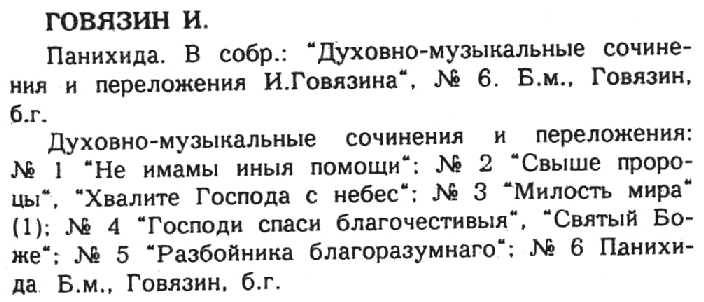

Ukazatel’ russkoi i inostrannoi literatury po voprosam russkogo tserkovnogo peniia.
Gardner, I.A. Miunkhen: [s.n.], 1958. 37 p.
U of I Library Call Number: History, Philosphy, & Newspaper FILM 016.783026 G17u
Published in Munich in 1958, this item is not discussed in the guides listed above. This bibliography provides citations for journal and newspaper articles on the subject of Russian church singing. Inspired by Preobrazhensky’s 1900 bibliography of Russian church singing (see p.31 of Bibliografiia muzykal’noi bibliografii for an annotation of that piece), Gardner’s work includes emigre and non-Russian publications in addition to Russian materials. Citations are listed alphabetically by author with a separate section for those works authored anonymously or signed only with initials. See the entry below for two works by Nadir-Bek.


Russkaia narodnaia pesnia: bibliograficheskii ukazatel’, 1735-1945 gg.
Moskva: Izd-vo. Akad. Nauk SSSR, 1962. 169 p.
U of I Library Call Number: International & Area Studies Russian Reference (Slavic) 016.782421 Si13r
This is a bibliography of Russian printed folk music texts and works about folk music published from 1735-1945. The citations include monographs as well as newspaper and journal articles. The text is divided into the two following sections each arranged chronologically by date of publication and then alphabetically within each date: publications of Russian folk song texts; publications of works about Russian folk songs. Although the compiler admits in the preface that this bibliography does not attempt to be comprehensive, nevertheless it is an excellent place to start doing research in this field. Unfortunately, there is only a name index to supplement the chronological arrangement. See the entries below from 1820 from the second section.


Russkaia narodnaia muzyka. Notograficheskii ukazatel’. (1776-1973). Ch.1, Ch.2.
Batser, D. Rabinovich, B. Moskva: Sovetskii kompozitor, 1981-1984. 2 reels
U of I Library Call Number: International & Area Studies Microform (Slavic) Film 016.781620947 B321r
Covering almost two centuries of Russian musical publications, this bibliography provides citations for Russian folk music published in books, anthologies and journals. The citations show the contents of collections and list accompanying recordings if applicable. The bibliography is divided into two sections: an index of vocal works and vocal/instrumental works and an index of instrumental works. The citations in the body of the work are arranged within these two sections alphabetically by author and if there is no author, then by title. There are numerous indexes such as for names, places, folksongs by a specific author, for sources listed in the bibliography, and for authors of folklorized materials. An appendix at the end includes publications appearing after 1973. The work opens with an overview of Russian folk music bibliography. See the entry below for the contents of a work entitled Pesni katorgi.


Card Catalog of the Scientific-Music Library of the Rimsky-Korsakov Conservatory, St. Petersburg.
New York: Norman Ross, 1994. 312 microfiches.
U of I Library Call Number: International & Area Studies Microform (Slavic) Mfiche 015.4721 C178 and Music & Performing Arts Special Collection ML136.S23 R46S3
This microfiche set is a facsimile of the card catalog of the Rimsky-Korsakov Conservatory in St. Petersburg. It contains cards for books on music from the 19th-century to the middle 1990’s such as biographies, histories of the theater, books on pedagogy, theory and other topics. In addition it covers music scores from the 18th century to the middle 1990’s. Manuscripts, photographs, letters and other special collections items from the 19th and 20th centuries held by the Conservatory also have cards in this catalog. The fiche 13 fiche are the catalog of the manuscript division, the next 33 fiche are for the printed books and the remaining 266 fiche are for the scores. According to the advertisement in the Norman Ross catalog, a section for Rare Books is in preparation. All three sections are arranged by main entry, that is by author/composer or by title if there is no author. Note that the items appear in Russian alphabetical order in spite of the fact that the guide words on the fiche are in the Latin alphabet. Also be aware that strict alphabetical order is not followed in all cases. For example, in the score section of the catalog, Prokofiev and Puccini appear after Rakhmaninov, which is incorrect in both Russian and English alphabetical order. See the card below which shows a letter in the manuscript division from one Dorfman to the Popechitel’nyi sovet in 1907 about a possible translation of Rimsky-Korsakov’s “Uchebnik garmonii.”
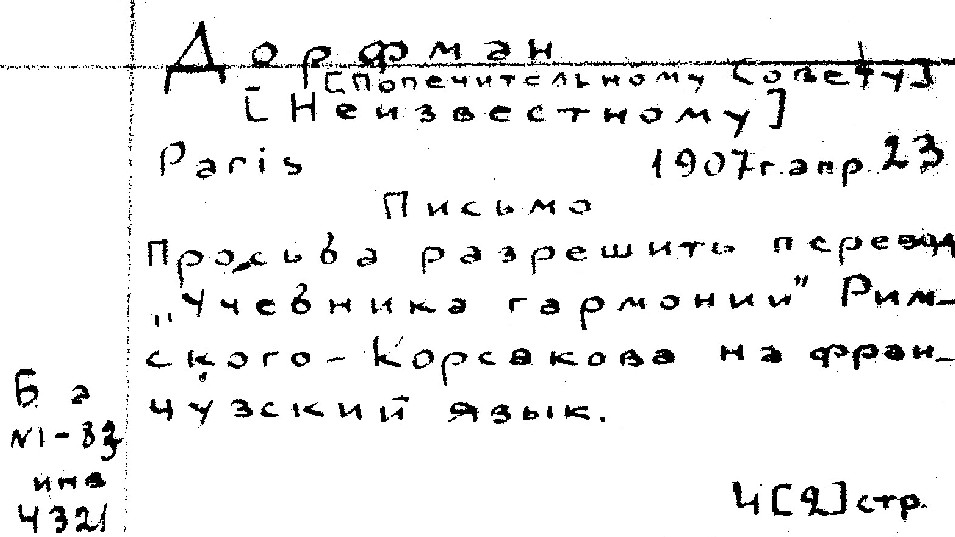

Card catalog of the State Ukrainian Conservatory, Kiev.
New York: Norman Ross, 2001. 188 microfiches.
U of I Library Call Number: Slavic Reference MFICHE 015.5777 N214c
This microfiche set reproduces the card catalog of the music conservatory in Kiev. It includes only printed music up to the mid-1990’s, not books or archival materials about composers like the catalog described above. The composers represented in this catalog are mostly art music composers from all countries including Russia and Ukraine. Cards are arranged by surname of composer or by title if it is a collection of musical works. When using the set beware that the alphabetical guide words at the top of each fiche are incorrect. See the card below as an example.
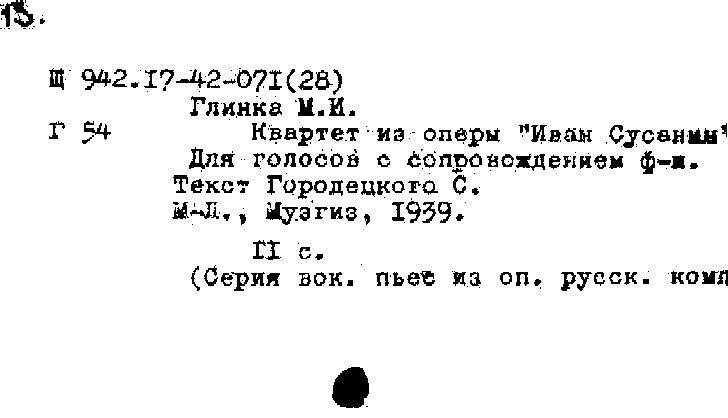
Discographies
Discography is a complicated question for Russia. Since recordings were not included as part of the national bibliography, it is harder to track systematically than the production of books or journals. Below are a few sources for later Russian discography that happen to be held at the University of Illinois Library. For other discographies or catalogs of recordings from Russia try searching WorldCat using a few of the following subject headings: sound recordings — catalogs; sound recordings — Russia — catalogs; sound recordings — Soviet Union — catalogs; discography — catalogs.
Thanks to the Reference Department of the Russian National Library in St. Petersburg we now know that the main issuing body for catalogs of recordings during the 1930’s was Gramplastrest. They issued a number of catalogs under the titles Bulleten’ vypuska gramplastinok or Assortimentnii katalog or Katalog grammofonnykh plastinok. Unfortunately, these catalogs are not held in US libraries.
The publishing company Norman Ross has produced microfiche copies of some pre-revolutionary record company catalogs, so these materials are more likely to be held by major Slavic collections in the US. Here it is in our catalog.
Melodiya: a Soviet Russian L.P. Discography.
Bennett, John R. ed. Westport, CT: Greenwood Press, 1981. 832 p. (Discographies ; n.6).
U of I Library Call Number: Music & Performing Arts Reference ML156.2 B36 and Music & Performing Arts 789.913 B439m
This discography covers Russian art music produced by the Soviet record company Melodiia. No publication dates are included in the citations, but since Melodiia was founded in 1964, we have to assume that is the earliest date this catalog covers. The works are listed alphabetically by composer and then in the following order: symphonies, orchestral works, instrumental works, operas, choral music, works for smaller vocal groups, and songs and romances. Citations include the Melodiia record number and information on performers and conductors. As for the actual titles of the recordings, unfortunately, this discography gives the impression that all of the works by Melodiia were produced in the English, German or French languages. No Russian citations are provided. There are indexes for artists and chamber groups as well as an appendix which lists special sets such as performances by great artists. See the entry below for some of the recordings of Verstovsky’s works.
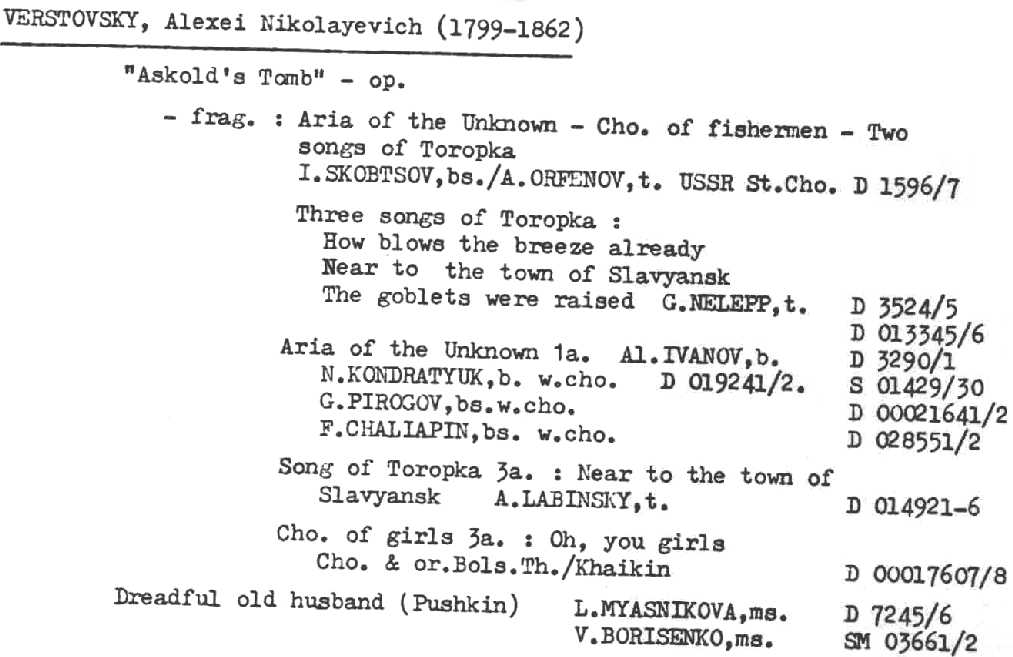

Melodiia. Ezhekvartal’nyi katalog-biulleten’ Vsesoiuznoi firmy gramplastinok “Melodiia”.
Moskva: Melodiia; Muzyka, 1979- .
U of I Library Call Number: Music & Performing Arts Periodicals 780.5 ME [UIUC has 1985-2005 [incomplete] + some later unbound issues]
Although this journal contains mostly articles about music and some reviews, it is included here because of the discographies that appear in almost every issue. During the 1980’s the section Katalog novykh gramplastinok contained detailed information about new releases from Melodiia such as title, record number, artists, length, etc. During the 1990’s the format of the journal started to change with issues being shorter and the Katalog section providing fewer entries with less details. However, as new record companies arose after the fall of the Soviet Union, their products began to be listed as well as Melodiia’s. With their scanty offerings in the 1990’s this journal hardly can be considered a complete discography of Russian music, but it may be helpful to some. In the 1980’s entries were arranged by type of recording: socio-political material, orchestral, chamber and vocal music, records for children, music of the peoples of the USSR, etc. In the 1990’s the entries are arranged by record company.
Bibliographies of Russian Literature in Music
A special subgroup of musical bibliography is the bibliography of literary and poetical works and literary references that are set to music. Several are described below. To find others for the works of specific authors that are not annotated in the subject guides above, try searching WorldCat using keyword subject headings such as “songs and music” and “bibliography” or “musical settings” and “bibliography”. If you limit the language to Russian, you will miss a particularly fine German bibliography of Pushkin’s works set to music, so try several searches. Leaving off the word “bibliography” will result in records for recordings and scores.
Russkaia poeziia v otechestvennoi muzyke (do 1917 goda). Spravochnik.
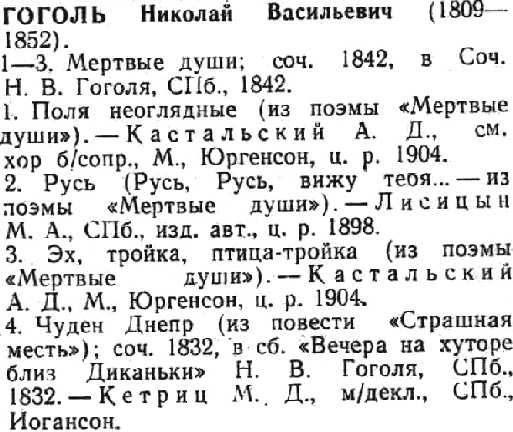
Ivanov, G.K. ed. Moskva: Muzyka, 1966. 436 p.
U of I Library Call Number: International & Area Studies Russian Reference (Slavic) 016.780947 Iv1r v.1
If you ever wanted to know if a particular Lermontov poem was set to music, this is the source that will give you the answer. Entries which are arranged alphabetically by surname of the poet provide citations for the poetic texts and the musical pieces that use them. There is also a section for folk texts set to music that is arranged by first line. The introductory article “Russkie poety i vokal’naia lirika” not only discusses the more famous instances of Russian poetry set to music, but also mentions earlier attempts at compiling bibliographies of this type. See the entries under Nikolai Gogol’.

Russkaia literatura v sovetskoi muzyke. Spravochnik. Vyp. 1 (A-L). Vyp. 2 (M-P).
Grigorovich, N.N. Moskva: Sovetskii kompozitor, 1975 + 1984.
U of I Library Call Number: International & Area Studies Russian Reference (Slavic) 016.780947 G87r v.1 and Microform (Slavic) Mfilm 016.780947 G87r v.2
Similar to the volume described above, this source also covers Russian literature in genres in addition to poetry and it covers music published between the dates of 1917 and 1966. Thus, it is in some sense the complementary work to Russkaia poeziia v otechestvennoi muzyke (do 1917 goda). Entries are arranged alphabetically by the surname of the literary figure and include citations for the published musical works. In some cases citations refer to unpublished musical manuscripts. Volume 1 covers surnames from A-L and volume 2 surnames from M-P. See the entry below for O.M. Brik.


Poeziia A.S. Pushkina v pesennikakh 1825-1917 gg. i russkom fol’klore. Bibliograficheskii ukazatel’ (po materialam Pushkinskogo Doma).
Mel’ts, M.Ia. Sankt-Peterburg: Dmitrii Bulanin, 2000. 215 p.
U of I Library Call Number: International & Area Studies Russian Reference (Slavic) 891.73 P97 AM495
For details of musical settings of Pushkin’s poetry, this book is very helpful. It covers published musical works from 1825-1917. The introductory essay covers this topic in great detail. The bibliography is divided into two main sections with supplementary features at the back. The first section is arranged alphabetically by first line and it has its own index at the end of the section. The second section is arranged chronologically. The supplementary features include a comparative chronological table, a table of works published during Pushkin’s lifetime, and bibliographies of oral works and film presentations, among others. See the entry below for the poem Veselyi pir.


Pushkin v muzyke. Spravochnik.
Vinokur, N.G., Kagan, R.A., eds. Moskva: Sovetskii kompozitor, 1974. 373 p.
U of I Library Call Number: Main Stacks 891.73 P97 Av77
At the time of publication of this title, more than 3000 musical works had been written to the words of Aleksandr Pushkin. This bibliography attempts to cite them all. The compilers availed themselves of library catalogs, published bibliographies, and periodicals as well as archival materials to compose their bibliography. The book is divided into 4 sections: works of Pushkin set to music, the same arranged by musical genres, musical works dedicated to Pushkin, and composers who set Pushkin’s texts to music. The entries in the first section are arranged alphabetically by title, in the second alphabetically within each musical genre, in the third section alphabetically by composer, and the fourth section also by composer. See the example below for the first few settings of “Ne poi, krasavitsa, pri mne.”
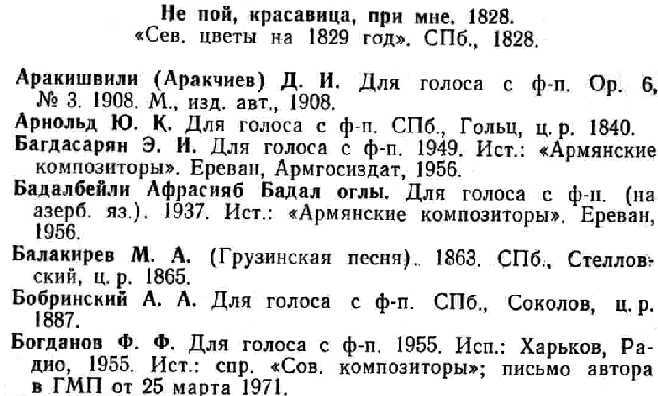

anniaia russkaia lirika. Repertuarnyi spravochnik muzykal’no-poeticheskikh tekstov XV-XVII vekov.
Petrova, L.A. i N.S. Sergina, eds. Leningrad: BAN, 1988. 409 p.
U of I Library Call Number: International & Area Studies Russian Reference (Slavic) 891.7091 R171
Working from manuscript sources that reside in archives and libraries in the former Soviet Union, the authors have compiled a systematic description of musical poetic texts from the 15th-17th centuries, in particular penitential poems (stikhi pokaiannye). The introduction gives a brief overview of the genre and the process of selecting the material for inclusion in the bibliography. The poems were taken from manuscript anthologies with the second half of the book providing detailed descriptions of each anthology and its contents. The first half of the book organizes the material by voice or tone (glas) 1-8. Theses entries are also very detailed with archival notations and bibliographic references as well as musical examples. There are indexes for names, first lines, titles, manuscript numbers and chronologies. Follow the link to view the first part of the first entry under Glas Pervyi.
Periodical Indexes for Music
See also Muzyka described above which covers the contents of selected music periodicals and monographs. Another item that we want to bring to your attention is a microfiche set of pre-revolutionary Russian journals on music. The University of Illinois holds this set under the call number and title Slavic mfiche 780.947 M973, Music journals from the National Library of Russia, St. Petersburg (1902-1914). Although this set is not indexed, it is a valuable periodical resource for Russian music. For the contents of the set see the U of I cataloging record.
Muzykal’naia bibliografiia russkoi periodicheskoi pechati XIX veka. Vyp.1, 1801-1825, Vyp.2, 1826-1840, Vyp.3, 1841-1850, Vyp.4:1-2, 1851-1860, Vyp.5:1-2, 1861-1870, Vyp.6:1-4, 1871-1880.
Livanova, T. ed. Moskva: Gos. Muzizdat, 1960-1979. 6 reels
U of I Library Call Number: History, Philosophy, & Newspaper FILM 016.780947 L743m v.1-6
This wonderful index provides access to musical literature published in major newspapers and journals from 19th century Russia. Each volume begins with a survey article on Russian music publishing for that decade. The volumes contain two parts: personalia and subjects. The first section lists entries alphabetically by the surname of the subject, such as Beethoven. The citations are for articles and reviews about that individual or his works. The second section has citations for articles based on general subjects such as musical theater, music theory, anecdotes, bibliography, etc. The sections on musical theater are subdivided geographically by Moscow, Saint Petersburg, the provinces, and foreign locales. There is an index of authors at the end.
Encyclopedias
Muzykal’naia entsiklopediia.
Iu.V. Keldysh, ed. Moskva: Sovetskaia entsiklopediia, 1973-1982. 6 vols.
U of I Library Call Number: International & Area Studies Russian Reference (Slavic) 780.3 M9882 v.1-6
One of the most useful tools for the study of Russian/Soviet music is the scholarly Muzykal’naia entsiklopediia. It includes articles on notable individuals, terms, movements, and subject-specific topics. It is an excellent resource for biographical information on Russian and Soviet composers, performers, conductors, etc. Famous foreign musical figures also merit entries in this work. Much like other encyclopedias, this one includes general biographical data and the highlights of an individual’s career, but it also includes excellent bibliographical references of works by and about the individual. Bibliographical references are also included for non-biographical topics. For example, the references at the end of the Tchaikovsky article span 5 pages of very small print. Longer articles are signed with the initials of the contributor. Portraits and other illustrations are scattered throughout the volumes. Entries are arranged alphabetically by topic or surname. Volume 6 contains a Dopolnenie from A to Ia with additional entries. See the entry below on the Russian soprano, Agafia Petrovna Iavorskaia.


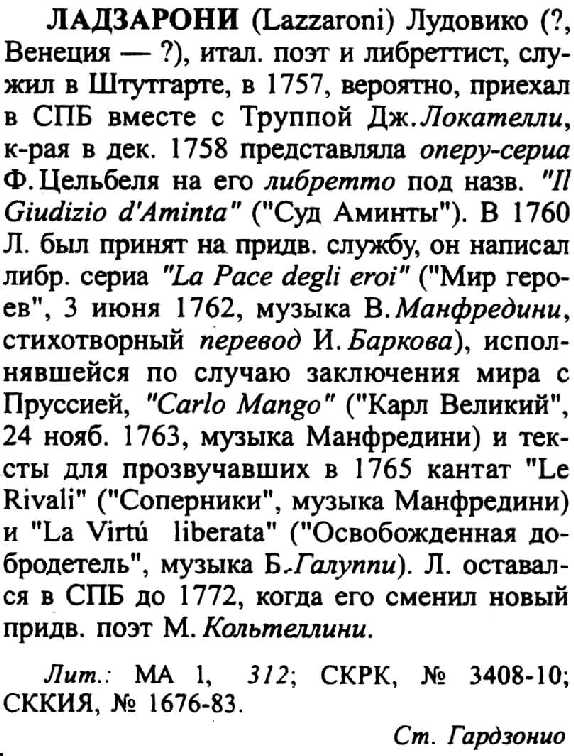
Muzykal’nyi Peterburg: Entsiklopedicheskii slovar’ XVIII vek.
Porfir’eva, A.L., ed. Sankt-Peterburg: Kompozitor, 1996- .
U of I Library Call Number: International & Area Studies Russian Reference (Slavic) 780.94721 M988 v.1, v.2
Musical culture of the 18th century is the subject of this encyclopedia. Many of the articles are about Russian and European musicians and composers active in St.Petersburg at the time. There are also good general articles such as Zhurnaly i muzyka. Entries are signed and include bibliographic and often archival references. They are arranged alphabetically by topic or surname. Only two volumes (up through P) have been published so far. See the entry to the right on the Italian librettist, Lazzaroni.

Muzykal’noe obrazovanie i muzykal’nye obshchestvennye organizatsii v Peterburge 1801-1917. Entsiklopediia.
Petrovskaia, I.F. Sankt-Peterburg: Izd-vo “Petrovskii fond”, 1999. 367 p.
U of I Library Call Number: International & Area Studies Russian Reference (Slavic) 780.7094721 P44e
This recent encyclopedia contains information about more than 110 societies and 140 institutions active in musical life and musical education in St.Petersburg. Although the focus of this work is organizations and not people, there are some articles on prominent figures and a name index. Articles vary from one paragraph to several pages in length, but all have bibliographic references and many have archival citations for locating where the pertinent collections are held. In fact, the articles themselves have additional citations embedded in the text.

Kontsertnaia zhizn’ Peterburga, muzyka v obshchestvennom i domashnem bytu 1801-1859 gody. Materialy dlia entsiklopedii “Muzykal’nyi Peterburg”.
Petrovskaia, I.F. Sankt-Peterburg: Izd-vo “Petrovskii fond”, 2000. 199 p.
U of I Library Call Number: International & Area Studies Russian Reference (Slavic) 780.94721 P449k
This volume is a continuation of the encyclopedia Muzykal’nyi Peterburg: Entsiklopedicheskii slovar’ XVIII vek. It covers the first half of the 19th century. The book is divided into two sections, subjects and personalia. The subject section has entries for general topics such as vocal music, for specific institutions in Saint Petersburg such as the Kammenoostrovskii teatr, and for musical instruments. The personalia section provides short biographies along with birth and death dates. The entries include bibliographic and archival references as well as many citations within the texts of the entries. See the entry below for Dvorianskoe sobranie.


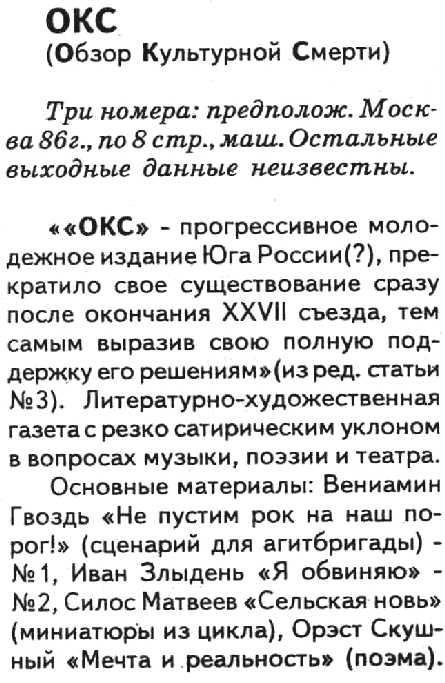
Zolotoe podpol’e. Polnaia illiustrirovannaia entsiklopediia rok-samizdata. Istoriia, antologiia, bibliografiia. 1967-1994.
Kushnir, A. ed. Nizhnii Novgorod: Izd-vo “Dekom”, 1994. 366 p.
U of I Library Call Number: International & Area Studies Russian Reference (Slavic) 016.781660947 K968z
This volume is divided into 3 sections: the encyclopedia, the anthology, and the appendix. The encyclopedia provides entries for rock samizdat periodicals that were produced in the Soviet Union from 1967-1994. The entries include editorial information, size and print runs along with a brief history of the titles, their scope and mentions of some of the more interesting articles that appeared in each title. The entries are arranged by city of publication and can be anywhere from a paragraph to several pages long. The anthology section reprints some of the seminal articles from the various periodicals covered in the encyclopedia section. Section three is the appendix with the tables of contents of some of the more well-known journals as well as an index of titles. The volume is amply illustrated. See the entry to the left on the Moscow journal Oks.
Dictionaries
Dates and facts concerning premieres are of particular interest to those researching music and theater arts. This information is often provided in general sources such as encyclopedias, but there are also entire works devoted to reproducing premiere information. One such resource is Slovar’ oper listed below.
Slovar’ oper vpervye postavlennykh ili izdannykh v dorevoliutsionnoi Rossii i v SSSR. 1736-1959.
Bernandt, G. Moskva: Sovetskii kompozitor, 1962. 554 p.
U of I Library Call Number: International & Area Studies Russian Reference (Slavic) 782.03 B456s
With detailed premiere information for operas produced by the peoples of the former Soviet Union, this dictionary contains over 1000 entries including operettas and other staged musical pieces. Entries contain premiere dates, cast of characters, and artists who originated the roles among other facts. The entries are arranged by the title of the opera with an appendix that includes operas by Soviet composers that premiered abroad. The text is supplemented by indexes for composer, librettist, author of literary works, director, producer, conductor, balletmeister, artist, and city of premiere. A final, useful appendix is the chronological listing of all the operas mentioned in the dictionary. See the entry below for Stravinsky’s Mavra.


Bol’shoi teatr. Pervye postanovki oper na russkoi stsene 1825-1993.
Zarubin, V.I. Moskva: Ellis Lak, 1994. 319 p.
U of I Library Call Number: International & Area Studies Russian Reference (Slavic) 792.50947 Z19b
Opera premieres at the Bolshoi Theater in Moscow are the subject of this specialized dictionary/encyclopedia. Articles which are often about a page in length provide basic data about the opera and its Bolshoi Theater premiere such as the performers, the composer, the date of the premiere and a short summary of the plot. Entries are arranged chronologically by premiere date, but several appendices enhance the text. For example, there is an opera repertoire for the Bolshoi from 1825-1993 which shows all of the operas staged during that time period, a list of all the directors of the theater, an alphabetical listing of all the operas inlcuded in the main part of the text, a name index and an index of opera roles. The volume is amply illustrated with both color and black and white images of performers and scenery. Follow the link to view the entry for Ravel’s comic operaL’heure espagnole or Ispanskii chas.
The companion volume on Bolshoi premieres of ballets is annotated on the page detailing Resources for Russian Cinema and Performing Arts.
Biographical Sources for Russian Music
There are several guides to Russian music which annotate extensive biographical materials. See Bibliografiia muzykalnoi bibliografii. Annotirovannyi perechen ukazatelei literatury, izdannoi na russkom iazyke and Spravochnaia literatura po muzyke. Slovari, sborniki biografii, kalendari, khroniki, pamiatnye knizhki, putevoditeli, sborniki libretto, sborniki tsitat which are annotated above. Please note that encyclopedias are also excellent sources of biographical information. See in particular those concerning music such as Muzykal’naia entsiklopediia and Muzykal’nyi Peterburg.
This section includes mostly biographical dictionaries or sets that are not covered in the Russian biographical archive. Those few that are both in the RBA and included here are of particular signifance and are noted as such. Resources for Russian biography are extremely rich and the Biographical Archive doesn’t even scratch the surface, so be sure to use it as a starting point only.
Sovetskie kompozitory i muzykovedy. Spravochnik v trekh tomakh.
Bernandt, G. B. ; IAmpol’skii, I. M. Moskva: Sovetskii kompozitor, 1978- .
U of I Library Call Number: International & Area Studies Russian Reference (Slavic) 780.92 B456s v.1, v.3:1
Including biographical articles on both Soviet composers and musicologists, this 3-volume set is handy for quick and dirty fact-checking and for its bibliographies at the end of every entry. Entries include basic biographical data such as dates, education and career highlights as well as the bibliographic references. Entries are arranged alphabetically by surname. The University of Illinois lacks volume 2 and volume 3 part 2, so the set covers A-I and S-F in Cyrillic alphabetical order. See the entry below for the musicologist, Olga Sokolova.
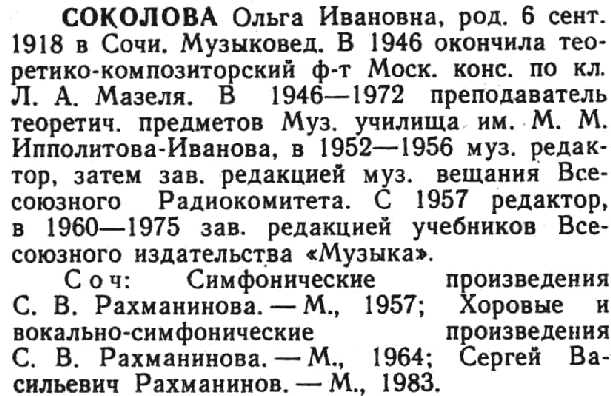

Ezhegodnik pamiatnykh muzykal’nykh dat i sobytii 1991. Spravochnoe posobie.
Moskva: Muzyka, 19- .
U of I Library Call Number: International & Area Studies Russian Reference (Slavic) 780 EZ39, 1991 + Oak Street Facility 780 Ez39 1975-1978, 1990
This is an unusual biographical source, a calendar of jubilee dates for the musical world occurring in the year 1991. For example, January 20, 1991 is the 100th anniversary of the birth of the Russian violinist, Misha El’man, (1891-1967). The book opens with the calendar of significant anniversaries. What follows are biographical articles, also arranged by calendar date, for individuals whose jubilees occur in 1991. Fortunately, there is a name index at the back so you do not need to know any significant dates to use this source. The articles mostly are a summation of the careers of the figures with some early biographical data incorporated. All articles are signed, but there are no bibliographical references. This source is actual an annual publication, but U of I holds only a few volumes. Follow the link for the article on the soprano, Margarita Aleksandrovna Eikhenval’d.

Biographical dictionary of Russian/Soviet composers.
Ho, Allan Benedict ; Feofanov, Dmitry. New York: Greenwood Press, 1989. 739 p.
U of I Library Call Number: Music & Performing Arts Reference ML106.S68 B56
With biographical information on over 2,000 Russian and Soviet composers and other famous musical figures, this dictionary claims to be the most comprehensive single-volume reference source of its kind published in the English language. The criteria for inclusion is being born in Russia or the Soviet Union or one of its former republics. Some emigres and foreign-born composers who lived in Russia and influenced Russian music are also covered. After the biographical entry, worklists and bibliographies are provided. Worklists are preceded by the capital letter W and bibliographies by the letter B. Much of this information is given with standard abbreviations for sources, such as NG for New Grove and S for Schwann. Discographies are interspersed in the worklists by means of abbreviations or D numbers for labels and recordings. Use the various abbreviation keys and appendices to facilitate the reading of the references. Appendix I is a supplementary list of composers who did not merit their own entry. These names have dates of birth and some bibliographic notes. There is also a list of the contributors and an index of names. See the entry below on Vladimir Kobekin.
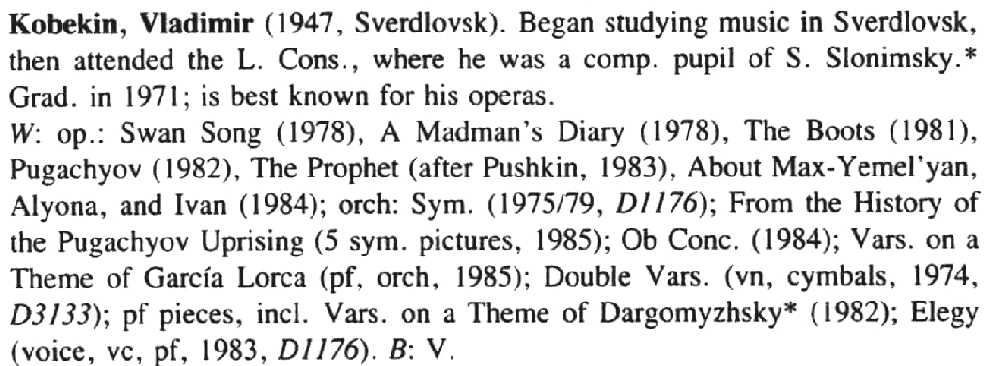

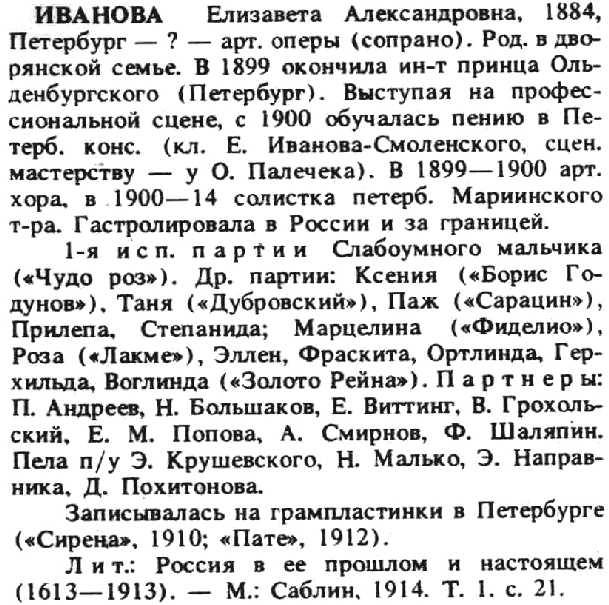
Otechestvennye pevtsy 1750-1917. Slovar’ v dvukh chastiakh.
Pruzhanskii, A.M. Moskva: Sovetskii kompozitor, 1991-2000. 2 vols.
U of I Library Call Number: International & Area Studies Russian Reference (Slavic) 780.92 P955o [U of I holds Chast’ 1 only]
This biographical dictionary contains entries for over 1000 Russian opera and chamber singers who performed both in Russia and abroad. The compiler has made a particular effort to include people who are rather obscure and thus will not appear in other biographical dictionaries. Entries include dates, education, notable performances, other career highlights, bibliographical references for items by and about the figures, and notes as to which companies they recorded with, if any. Many of the entries are fairly long, covering several columns of print. There are also many photographs of many performers in operatic costume. See the short entry on the left for the soprano, Elizaveta Aleksandrovna Ivanova.
Subject Websites
There are thousands of web sites in Russia devoted to musical topics as well as many sites produced outside of Russia about Russian music. The challenge is to sift through all of them to find what you need. The first step is to try to find a portal or gateway site that covers the genre of music that you are interested in. There are some good portals for classical music, some for rock, etc., but unfortunately, we have not found yet one truly excellent portal that covers all of the genres of Russian music.
How do you find Russian music portals? You can try going to any big Russian gateway or search engine such as Yandex or Mail.ru and search the terms “muzyka,” “portal.” You can also try this (using English search terms such as Russian music portal) in a western search engine such as Google. Some of the biggest sites will appear, for example www.zvuki.ru and muz.ru. Most of these portals include links to other sites as well as news of the industry. Many of them also have MP3 archives.
Another option is to look for some person or organization who has gathered links on Russian music and produced some kind of guide to these sites. There are several of these which may be helpful in beginning your search for internet resources on Russian music. For example, the Russian Studies Program at Bucknell maintains an annotated list of English-language sites on Russian music and the REESWeb at the University of Pittsburgh has a section on music with many annotated sites listed. There are many such guides to the internet that have been produced by Slavic Departments or Slavic centers around the world and most of them have sections on culture and/or music. Please keep in mind that websites are often most useful for current, not historical or in-depth, information.
